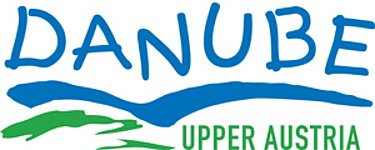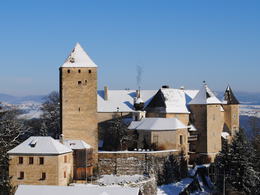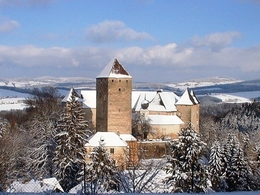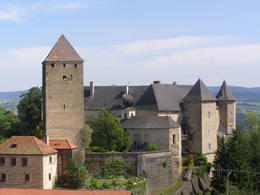Vichtenstein Castle
Vichtenstein, Oberösterreich, Österreich
Vichtenstein 1
4091 Vichtenstein
4091 Vichtenstein

Vichtenstein Castle was built around 1100 by the Counts of Formbach.
Vichtenstein Castle - of feud and the bishop's victoryThe romantic Vichtenstein Castle is located in the centre of Vichtenstein, just a few metres off the Donausteig trail. It was probably founded in the 11th century by one of the Counts of Formbach. After this dynasty died out in 1145, the castle passed to the Hallgraves of Wasserburg. In 1217, a reversal of fortune began that was to throw the region into turmoil for years! Konrad Count of Wasserburg and Vichtenstein wanted to go on a crusade to the Holy Land and borrowed money from the Prince-Bishop of Passau. As a pledge, he gave Vichtenstein Castle with its numerous possessions. Before his departure, Konrad married and signed the castle over to his wife. However, the Bishopric of Passau regarded the castle as her property and considered this transfer to be unlawful. Thus began an 8-year feud between Konrad and the bishopric. He harmed Passau wherever he could: he destroyed Passau property, attacked Passau merchants, blockaded the Danube, ... His strategic "masterpiece": as Passau's prosperity was based on the salt trade, Konrad channelled the salt from Salzburg past Passau! He utilised his salt trading privileges as Hallgraf and had the salt transported down the Inn River landed in Schärding. It was then transported overland via Münzkirchen, Vichtenstein and Kasten to Obernzell, from where it found its usual route to Bohemia. In doing so, he not only damaged Passau, but also made very good money himself! Konrad was finally excommunicated several times (!) for his actions and later even ostracised. In the end, however, he had to give in. In 1227, Vichtenstein became the property of the Bishopric of Passau for the next 550 years. Soon afterwards, the newly founded Engelszell Monastery was supported by being exempted from the Vichtenstein toll and also received all the storm-damaged trees of the Vichtenstein dominion in 1299. In later years, the castle was a favourite hunting lodge of the Passau bishops. The Jagabild chapel on the ridge of the Haugstein has some marvellous stories to tell about this time of hunting! Find out more under "Jagabild Chapel - a marvellous gem!". In 1803, the rule of the Bishopric of Passau ended through secularisation and Vichtenstein Castle fell to the Austrian state. From 1860 onwards, a period of eventful private ownership began. Today, the castle is owned and inhabited by the Schulz-Wulkow family.
The castle cannot be visited! (Source: Schulz-Wulkow, K. (2012). Vichtenstein in the Sauwald)
By the way: Castle mounds used to be kept free of woodland for military reasons. This also helped Linz's Pöstlingberg to become a popular vantage point after the Maximilian fortifications were abandoned. Today, the Pöstlingberg is the landmark of Linz and a must-see for every Donausteig hiker!
4091 Vichtenstein
Phone +43 7714 8055
Fax machine +43 7714 8055 - 31
E-Mail m.haderer@vichtenstein.ooe.gv.at
Web www.vichtenstein.at
http://www.vichtenstein.at
Contact person
Gemeinde Vichtenstein
Vichtenstein 70
4091 Vichtenstein
Phone +43 7714 8055
Fax machine +43 7714 8055 - 31
E-Mail m.haderer@vichtenstein.ooe.gv.at
Web www.vichtenstein.at
- Can only be viewed from outside
Elevation
536 m
Parking- Parking space: 30
- Food and drink available
- Suitable for single travelers
- Suitable for friends
- Suitable for couples
Please get in touch for more information.
Suggest changes
Please let us know how we can improve the quality of this object or if there is any incorrect information on this page (eg. opening hours, contact, etc.).
Please fill in all fields marked *.




